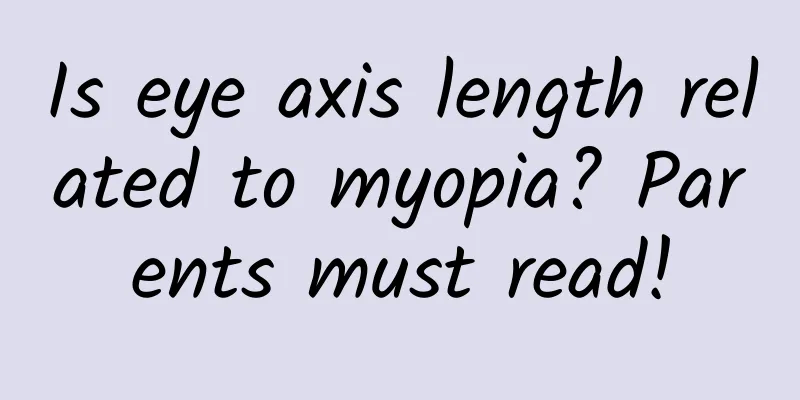Is eye axis length related to myopia? Parents must read!

|
What is axial length examination? Is it related to myopia? Correct understanding of eye axis Our eyeball is a nearly spherical shape. The distance from the outermost layer of the eyeball that receives light, that is, from the cornea-lens-vitreous body-retina, is called the "eye axis" length.
The axial length of the eye increases with age, just like our height. It will only grow and not shorten, and it is irreversible. If you find that your child's eye axis is outside the reference range, you need to be alert! As the eye axis continues to grow, the focal point falls in front of the retina, and myopia will form. The longer the eye axis, the deeper the myopia. On average, myopia deepens by about 250-300 degrees when the eye axis grows 1mm. Monitoring the growth of the axial length is one of the important indicators for evaluating a child’s refractive development. The axial length of children of different ages is also different. On the one hand, measuring the axial length of the eye is to evaluate the axial length and age to see if they match. On the other hand, it also depends on the growth rate of the axial length. The faster the axial length grows, the higher the degree of myopia. It is like blowing a balloon. When the balloon is small, the wall of the balloon is thick. When the balloon becomes larger, the wall of the balloon will become thinner. The relationship between eye axis and refraction The refractive power of the eye is mainly determined by the corneal curvature, axial length, and the refractive power and position of the lens. Corneal curvature is the curvature of the cornea. The average corneal curvature is about 43D. If it is higher than 43D, the center of the cornea is steeper, and if it is lower than 43D, the center of the cornea is flatter. During eye development, the corneal curvature is relatively stable at the age of 3. The lens changes slowly, so the axial length can be considered the only variable. It can also be simply understood as: refractive power ≈ corneal curvature + lens refractive power + eye axis. Regularly measure the eye axis Generally, a 3-year-old child can cooperate with the measurement of the axial length of the eye. Axial length measurement is a non-invasive examination that does not require mydriasis. It is a more objective monitoring indicator than visual acuity or even myopia. For children in the growth and development period, the axial length of the eye can be measured every 3-6 months. Prevent eye lengthening 1. Pay attention to children's eye use standards and maintain good eye habits; 2. Take your children outdoors more often to get in touch with nature and natural light; 3. Take your child to have their eyes checked regularly, and you can go to the optometry center to establish a child optometry file; 4. If you already have myopia, follow your doctor's advice and undergo optical correction. |
>>: The entanglement between cold and myocarditis
Recommend
Can purslane survive in winter? How to grow purslane in winter
Purslane is very common in rural areas. People wi...
What is the reason for worms in the lower body
The situation of lice growing in the lower body i...
25 When is the menstrual period dangerous?
Most women who want to have children know their s...
Do Type 3 Breast Nodules Require Surgery?
What should I do if I have a breast lump? The ini...
Can I eat black fungus during confinement?
Women need to strictly control their diet during ...
Sitting position that helps the fetus enter the pelvis
Engagement in the pelvis is a prerequisite for th...
How is Apieu Lip Glaze CR03? Apieu Lip Glaze CR03 Usage Review
I want to scream for Apieu every day, how can it ...
What are the dangers of gynecological cysts?
Cytopathology is often used in the diagnosis of s...
How to drive away the cold during confinement, and learn about the recipes to drive away the cold
Confinement is the most important stage for women...
Can pregnant women drink ginger and jujube tea?
Pregnant women are the group that needs to be mor...
What to do if your hands and feet are swollen during late pregnancy
The happiest moment in every woman’s life is when...
What can I eat to relieve nausea and vomiting during pregnancy?
In modern society, the physical condition of each...
The harm of girls wearing high heels
Girls all want to look tall, so both tall and sho...
What foods should I eat during pregnancy to keep my baby's skin good?
When pregnant women are pregnant, they all have a...
The skin will become worse ten days before menstruation
As the saying goes, everyone loves beauty. Pursui...









